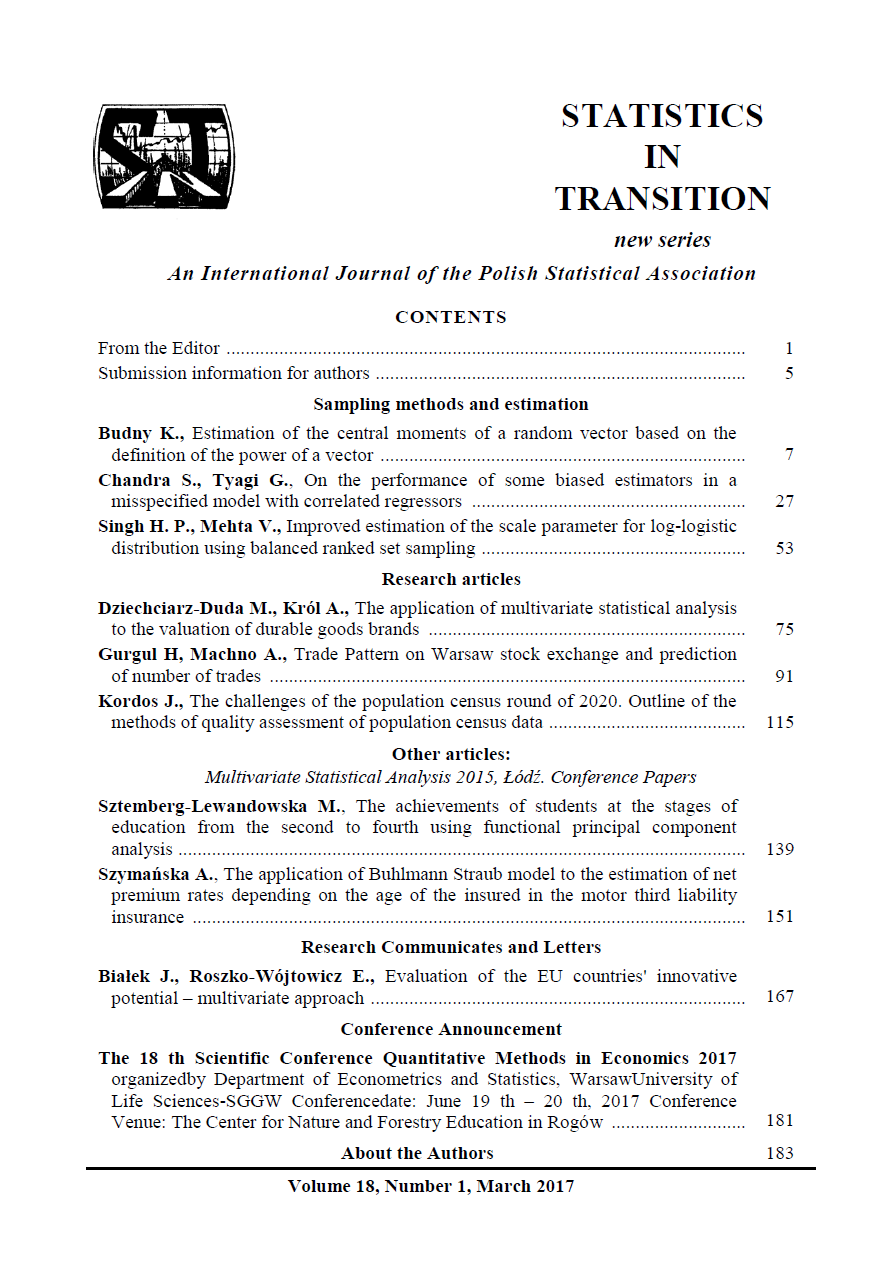ARTICLE
ABSTRACT
Nowadays, due to changes in the market and new trends in consumer behaviours, intangible assets, such as brand, have gained fundamental importance. The more frequent conviction that a product with a well-known name is better than other products contributes to the case of replacing the price of a product by its brand name as the predominant factor in the purchase decision process. Thus, for many companies the strengthening of brand equity has become one of the key elements of marketing strategy. The main aim of this study is an attempt to improve the process of analysing the position and value of brands using selected multivariate statistical analysis methods (hedonic regression, multidimensional scaling, classification and linear ordination methods). In the conducted research the direct approach to the evaluation of the position of the brands for a selected ICT good – smartphones – have been applied. The measurement was performed on two levels: the product level, in which the prices of branded products were compared, and the consumer level, where the perception and attitudes of consumers towards the brands were studied. The analyses have been carried out on two sets of data, which enabled fuller and more comprehensible understanding of decision rules that guide consumers in choosing the brand.
KEYWORDS
brand valuation, multivariate statistical analysis, durable goods.
REFERENCES
AAKER, D. A., (1991). Managing Brand Equity, New York: The Free Press.
AILAWADI, K. L., LEHMANN, D. R., NESLIN, S., (2002). A Product-Market Based Measure of Brand Equity. Marketing Science Institute Working Paper,02-102.
AMERICAN MARKETING ASSOCIATION, (1960). Marketing Definitions: A Glossary of Marketing Terms, Chicago: American Marketing Association.
BALTAS, G., SARIDAKIS, C., (2010). Measuring Brand Equity in the Car Market:a Hedonic Price Analysis. Journal of the Operational Research Society, 61(2),284–293.
BRACHIGNER, H. W., (2002). Statistical Theory of Hedonic Price Indices. DQE Working Papers, 1, Switzerland: Department of Quantitative Economics, University of Freiburg/Fribourg.
COBB-WALGREN, C. J., RUBLE C., DONTHU, N., (1995). Brand Equity, Brand Preference, and Purchase Intent. Journal of Advertising, 24(3), 25–40
DE CHERNATONY, L., DALL’OLMO RILEY, F., (1998). Defining a „Brand”:Beyond the Literature with Experts’ Interpretations. Journal of Marketing Management, 14(5), 417–443.
DZIECHCIARZ, J., et al., (1986). Ekonometria z elementami programowania matematycznego i analizy porównawczej, Bartosiewicz S. (ed.); Wrocław: Wyd.AE.
DZIECHCIARZ, J., (2004). Regresja hedoniczna. Próba wskazania obszarów stosowalnosci. In Przestrzenno-czasowe modelowanie i prognozowanie zjawisk gospodarczych. A. Zelias (ed.), Kraków: Wyd. AE, 163–175. ´
DZIECHCIARZ, M., (2008). Deklaracje intencji zakupu w analizie wyposażenia gospodarstw domowych w innowacyjne dobra trwałego uzytku. In ˙ Za stosowania badań marketingowych w procesie tworzenia nowych produktów (cena, opakowanie, znak towarowy), S. Kaczmarczyk, M. Schulz (eds.), Torun:´TNOIK, 157–166.
DZIECHCIARZ-DUDA, M., KRÓL, A., (2016). The Analysis of Consumers’ Preferences with the Application of Multivariate Models: Hedonic Regression and Multidimensional Scaling. Archives of Data Science, under review.
ERDEM, T., SWAIT, J., (1998). Brand Equity as a Signalling Phenomenon. Jour nal of Consumer Psychology, 7(2), 131–157.
ERDEM, T., SWAIT, J., BRONIARCZYK, S., CHAKRAVARTI, D., KAPFERER,J. N., KEANE, M., ROBERTS, J., STEENKAMP, J-B. E. M., ZETTELMEYER,F., (1999). Brand Equity, Consumer Learning and Choice. Marketing Letters, 10(3), 301–318.
HELLWIG, Z., (1968), Zastosowanie metody taksonomicznej do typologicznego podziału krajów ze wzgl˛edu na poziom ich rozwoju oraz zasoby i struktur˛e wykwalifikowanych kadr, Przegl ˛ad Statystyczny, 4, 307–326.
KAMAKURA, W. A., Russell, G. J., (1993). Measuring Brand Value with Scanner Data. International Journal of Research in Marketing, 10(1), 9–22.
KELLER, K. L., (1993). Conceptualizing, Measuring, and Managing Customer based Brand Equity. Journal of Marketing, 57(1); 1–22.
KELLER, K. L., LEHMANN, D. R., (2006). Brands and Branding: Research Findings and Future Priorities. Marketing Science, 25(6), 740–759.
MAURYA, U. K., MISHRA, P., (2012). What Is a Brand? A Perspective on Brand Meaning. European Journal of Business and Management, 4(3), 122–134.
MORWITZ, V., SCHMITTLEIN, D., (1992). Using segmentation to improve sales forecasts based on purchase intent: which „intenders” actually buy? Journal of Marketing Research, 29(4), 391–405.
NETEMEYER, R. G., KRISHNAN, B., PULLING, C., WANG, G., YAGCI, M.,DEAN, D., RICKS, J., WIRTH, F., (2004). Developing and Validating Mea sures of Facets of Customer-based Brand Equity. Journal of Business Re search, 57 (2), 209–224.
WALESIAK, M., GATNAR, E. (2004). Metody statystycznej analizy wielowymi arowej w badaniach marketingowych, Wrocław: Wyd. AE.
WHITE, H., (1980). A Heteroskedasticity-Consistent Covariance Matrix Estimator and a Direct Test for Heteroskedasticity. Econometrica, 48(4), 817–838
